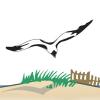I’m not a lifelong resident nor was I ever a lifeguard on our beaches, but the recent letter to the editor by James Riordan and Katherine Ware upset me at the total lack of understanding and shows how words can be manipulated to paint an entirely fictional approach to an issue.
First, one should understand the subject matter to form a truthful position. The current Canada goose hunting season is not for migrating birds. The true wild, migrating goose won’t arrive in this area until later October in its annual trek to warmer areas. We live in the Atlantic flyway of the four conduits south, and our migratory birds come through in the October timeframe.
The birds here are considered “resident geese” that are the byproduct of parents who decided the area was one they had no need to migrate to or from. Those birds, which I addressed to DNREC repeatedly in the mid-70s likely came about after having been wounded during hunting season. Canada geese are monogamous for life until one is killed by predators, hunters or dies of natural causes. Wounded ganders and geese have a natural instinct to mate, and if a partner is available, a new monogamous relationship is created. Their offspring have no mentors and their flights consist of finding foods in local farm fields or on parks, golf courses or those ubiquitous “run-off ponds” in developments and shopping malls.
The statement about the huge migratory flocks of the early ’90s was actually much less than they were in the 1970s when I first arrived in our Small Wonder. There’s a glaring reason for this in that an area that once grew countless acres of wheat, soybeans and corn has, over that time, begun growing houses. Unbridled development (as the author noted in “areas between subdivisions”) drastically restricted the Atlantic Flyway to a trickle of what it once was.
Second is the statement about hunters using lead shot. In 1987, state and federal reserves banned the use of lead shot for migratory birds. This restriction became nationwide in 1991. Shot used to hunt waterfowl must contain no lead. Commercial brands today are almost exclusively steel. As a side note, shotguns have triggers pulled, pistols have triggers squeezed. Patterns at close range are less than half what this writer mentions.
The Canada goose is not anywhere close to being endangered, and constant monitoring by state and federal wildlife agencies manages limits of these birds on the capacity and health of the species. It would be a blessing if feral cats and other invasive species had the same scrutiny and the same controls.
The resident Canada goose has become a pest, and state agencies have been given the latitude to decide both seasons and bag limits. Their ever-increasing numbers continue to create a situation in the environment that would become untenable without good conservation practices. The authors obviously have never walked a golf course or park area where the geese live. Goose droppings permeate where no one would want their child to play. Ponds are literally toxic from these droppings. There are no fish, other than perhaps a catfish or two, that could survive the levels of nitrates and chemical runoffs of that area. Daresay aquatic sports are not something one would like to think about. As for the fields, farmers already have enough issues from overburdensome wildlife. They know these birds have no intention of resting there, but to feast on the new crops just coming up. A flock of geese fouling the soil and pulling up crops just adds to their problems. Instead of using inflammatory words like “massacre,” “warlike horror,” “blown to bits” and “flailing in agony,” children (and many adults, obviously) should be taught about stewardship and wildlife conservation. They should be introduced to the American Model of Wildlife Conservation. The constant and incessant intrusion of people has irreversibly affected nature and the habitat of native animals. It may be the woke generation harping on the environment, but you can’t measure cow flatulence while ignoring resident geese paving our landscape with feces. Everyone lives downstream.

















































